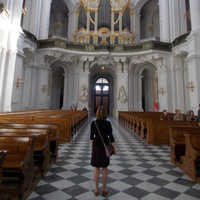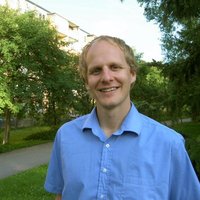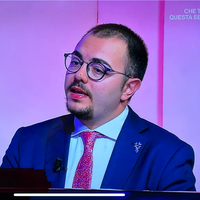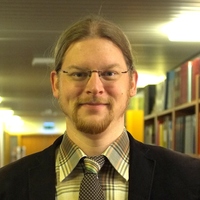
Stephen G Nuske
Australian, Emeritus Lutheran Pastor, liturgist, ecumenist and historian.
Nuske is a graduate of Luther Theological Seminary (1975-1982) now known as Australian Lutheran College, in Adelaide, South Australia. Final year Thesis: 'Theosis: Doctrine or Speculation?'
His work experience is as a Parish Pastor where he was enriched in various contexts. This was in the Bethania Parish, Queensland (including Daisy Hill), 1983-1990; at Bethlehem Church, Flinders Street, Adelaide, South Australia from 1990-1996; and at St Andrew's, Brisbane, Queensland, 1996-2015. The subject of ritual and pastoral care, privately and publicly, became an interest, an influence from his 'Vicar father', Paul Renner.
Nuske served the national and state church in various capacities: Commission on Worship, Department of Liturgics, and Department of Visual Arts. In Queensland, he served in chaplaincy roles (Bethania Lutheran Primary School, Hospitals, Queensland University of Technology, Conservatorium of Music). He was for a time President of the State Ecumenical body called Queensland Churches Together and served on its Executive Committee for a number of years. In Brisbane he represented the Lutheran Church and its Bishop in various city contexts: State, ecumenical and multi-faith. Nuske has always had an interest in History. He attempted a PhD at the University of Queensland in the Department of History, Philosophy, Religion and Classics on the subject of 'the development of inner city Lutheran Churches in nineteenth century Australia', a subject which went beyond 'Lutheran = German' in the English Australian context. A component of the research was Charles and Anne Steinkopff in London and the Nordic-Scandinavian churches in the Australian capital cities along the coastline. The subject of the 'city' became a deep interest because he served in two inner city churches for about 25 years. The subjects of 'cultus publicus', language, culture, ritual, public square, architecture, hymnody and music became interests. Current reading and research includes Scandinavian Lutherans in Australia, the Sorbs/Wends of Gnadenthal in Western Victoria, the influence of Pietism on the Sorbs, ‘memory’ studies, Hope Vale in north Queensland and First Nation (the ‘pink’ report - Church visitation of 1978), hagiography in the Lutheran tradition, the Church of the Byzantine rite and iconography, the history of Quebec and Franco-Americans, and what is central on Lutheran altars… He also has an interest in family history. He is a supporter of the Geelong Football Club in the Australian Football League.
See the CV for elaboration
Address: Tamborine Mountain
Queensland
Australia 4272
Nuske is a graduate of Luther Theological Seminary (1975-1982) now known as Australian Lutheran College, in Adelaide, South Australia. Final year Thesis: 'Theosis: Doctrine or Speculation?'
His work experience is as a Parish Pastor where he was enriched in various contexts. This was in the Bethania Parish, Queensland (including Daisy Hill), 1983-1990; at Bethlehem Church, Flinders Street, Adelaide, South Australia from 1990-1996; and at St Andrew's, Brisbane, Queensland, 1996-2015. The subject of ritual and pastoral care, privately and publicly, became an interest, an influence from his 'Vicar father', Paul Renner.
Nuske served the national and state church in various capacities: Commission on Worship, Department of Liturgics, and Department of Visual Arts. In Queensland, he served in chaplaincy roles (Bethania Lutheran Primary School, Hospitals, Queensland University of Technology, Conservatorium of Music). He was for a time President of the State Ecumenical body called Queensland Churches Together and served on its Executive Committee for a number of years. In Brisbane he represented the Lutheran Church and its Bishop in various city contexts: State, ecumenical and multi-faith. Nuske has always had an interest in History. He attempted a PhD at the University of Queensland in the Department of History, Philosophy, Religion and Classics on the subject of 'the development of inner city Lutheran Churches in nineteenth century Australia', a subject which went beyond 'Lutheran = German' in the English Australian context. A component of the research was Charles and Anne Steinkopff in London and the Nordic-Scandinavian churches in the Australian capital cities along the coastline. The subject of the 'city' became a deep interest because he served in two inner city churches for about 25 years. The subjects of 'cultus publicus', language, culture, ritual, public square, architecture, hymnody and music became interests. Current reading and research includes Scandinavian Lutherans in Australia, the Sorbs/Wends of Gnadenthal in Western Victoria, the influence of Pietism on the Sorbs, ‘memory’ studies, Hope Vale in north Queensland and First Nation (the ‘pink’ report - Church visitation of 1978), hagiography in the Lutheran tradition, the Church of the Byzantine rite and iconography, the history of Quebec and Franco-Americans, and what is central on Lutheran altars… He also has an interest in family history. He is a supporter of the Geelong Football Club in the Australian Football League.
See the CV for elaboration
Address: Tamborine Mountain
Queensland
Australia 4272
less
Related Authors
Elisabeth Urtel
Concordia Seminary
Donald Engebretson
Concordia Theological Seminary
J. Gertrud Tonsing
University of South Africa
Randall McElwain
Hobe Sound Bible College
Mattias Lundberg
Uppsala University
Alberto Annarilli
Università degli studi di Roma Tor Vergata
Esther Criscuola de Laix
A-R Editions, Inc.
Werner Schäfke-Zell
University of Copenhagen
InterestsView All (24)









Uploads
Teaching Documents by Stephen G Nuske
and the Liturgy. Influences are Saint Modestos, Saint Francis of Assisi,
Martin Luther’s Small Catechism, and the small book by Jack Wintz,
Will I See my Dog in Heaven? (Brewster, Massachusetts: Paraclete Press, 2009).
Prior to the 140th anniversary of the first Scandinavian Lutheran Service commemorated at St. Andrew’s in Brisbane in 2012, Norwegian historian, Fredrik Larsen, then a Masters candidate of the University of Oslo, electronically sent to me eleven articles from the Almindelig Kirketidende. Larsen had been researching Norwegian migration to Queensland. But fruit was dropping out of a little known aspect of the Church’s family tree! Copies of the Almindelig Kirketidende are held in the School of Mission and Theology in Stavanger, Norway. These eleven articles are to do with the Scandinavian Lutheran Church in Queensland. Nine of the articles were written by the pastor, Jens Christian Pedersen. The bulk of these articles have now been translated, thanks to the diligence of Norwegian born Odd Steinar Dybvad-Raneng who is a member of St. Andrew’s congregation. Of these, the 1883 ‘Letter from Pastor Pedersen’ and the ‘Letter to Members of the Nordic Church, who live in Freestone and Upper Swan Creeks’ are produced below.
I also offer some musings and reflections.
This is, therefore, an evangelical catholic emphasis. But with the distinctives in the Lutheran communion. The calendar aims to be ecumenical but with a strong Lutheran flavour. The Lutheran communion 'downunder' is a 'little church' but in a big Tree...
My hunch is that, with the advent of much technology used in 'worship services', many people in the Australian context no longer have access to the church year which was published in the Lutheran Hymnbook, with minor festivals. But this is much mote about minor festivals. It is about hagiography. Perhaps, too, as I write this, in the midst of the Corona Virus, as we retreat into our 'monasteries of the heart', we need to remember that we are surrounded by a great cloud of witnesses. My own grandmother died during the Spanish flu epidemic in 1919, when my mother was 3 months old. How many died worldwide? 50 million? Lest we forget.
“Do you think that I have come to bring peace to the earth? No, I tell you, but rather division! …” All this talk of fire and division and households deeply divided. All this against stuff in a family. Its as if Jesus some kind of divine family arsonist instead of the Prince of Peace.
and the Liturgy. Influences are Saint Modestos, Saint Francis of Assisi,
Martin Luther’s Small Catechism, and the small book by Jack Wintz,
Will I See my Dog in Heaven? (Brewster, Massachusetts: Paraclete Press, 2009).
Prior to the 140th anniversary of the first Scandinavian Lutheran Service commemorated at St. Andrew’s in Brisbane in 2012, Norwegian historian, Fredrik Larsen, then a Masters candidate of the University of Oslo, electronically sent to me eleven articles from the Almindelig Kirketidende. Larsen had been researching Norwegian migration to Queensland. But fruit was dropping out of a little known aspect of the Church’s family tree! Copies of the Almindelig Kirketidende are held in the School of Mission and Theology in Stavanger, Norway. These eleven articles are to do with the Scandinavian Lutheran Church in Queensland. Nine of the articles were written by the pastor, Jens Christian Pedersen. The bulk of these articles have now been translated, thanks to the diligence of Norwegian born Odd Steinar Dybvad-Raneng who is a member of St. Andrew’s congregation. Of these, the 1883 ‘Letter from Pastor Pedersen’ and the ‘Letter to Members of the Nordic Church, who live in Freestone and Upper Swan Creeks’ are produced below.
I also offer some musings and reflections.
This is, therefore, an evangelical catholic emphasis. But with the distinctives in the Lutheran communion. The calendar aims to be ecumenical but with a strong Lutheran flavour. The Lutheran communion 'downunder' is a 'little church' but in a big Tree...
My hunch is that, with the advent of much technology used in 'worship services', many people in the Australian context no longer have access to the church year which was published in the Lutheran Hymnbook, with minor festivals. But this is much mote about minor festivals. It is about hagiography. Perhaps, too, as I write this, in the midst of the Corona Virus, as we retreat into our 'monasteries of the heart', we need to remember that we are surrounded by a great cloud of witnesses. My own grandmother died during the Spanish flu epidemic in 1919, when my mother was 3 months old. How many died worldwide? 50 million? Lest we forget.
“Do you think that I have come to bring peace to the earth? No, I tell you, but rather division! …” All this talk of fire and division and households deeply divided. All this against stuff in a family. Its as if Jesus some kind of divine family arsonist instead of the Prince of Peace.
Texts for the homily: Jeremiah 29:1, 4-7; Revelation 7:9-12, 17; John 17:1, 20-23
But all of this physicality has now been stripped away because of the COVID-19.
In what follows, I have also indicated hymnody in the endnotes, in the hope that there may be a Hymnal lying around somewhere in homes. So people can sing to themselves. Or devotional use. Meditation. A book and away from screens. I know that endnotes are unusual in a sermon. So this is not ‘user friendly’. But it is also in the hope that collective memory may kick in.